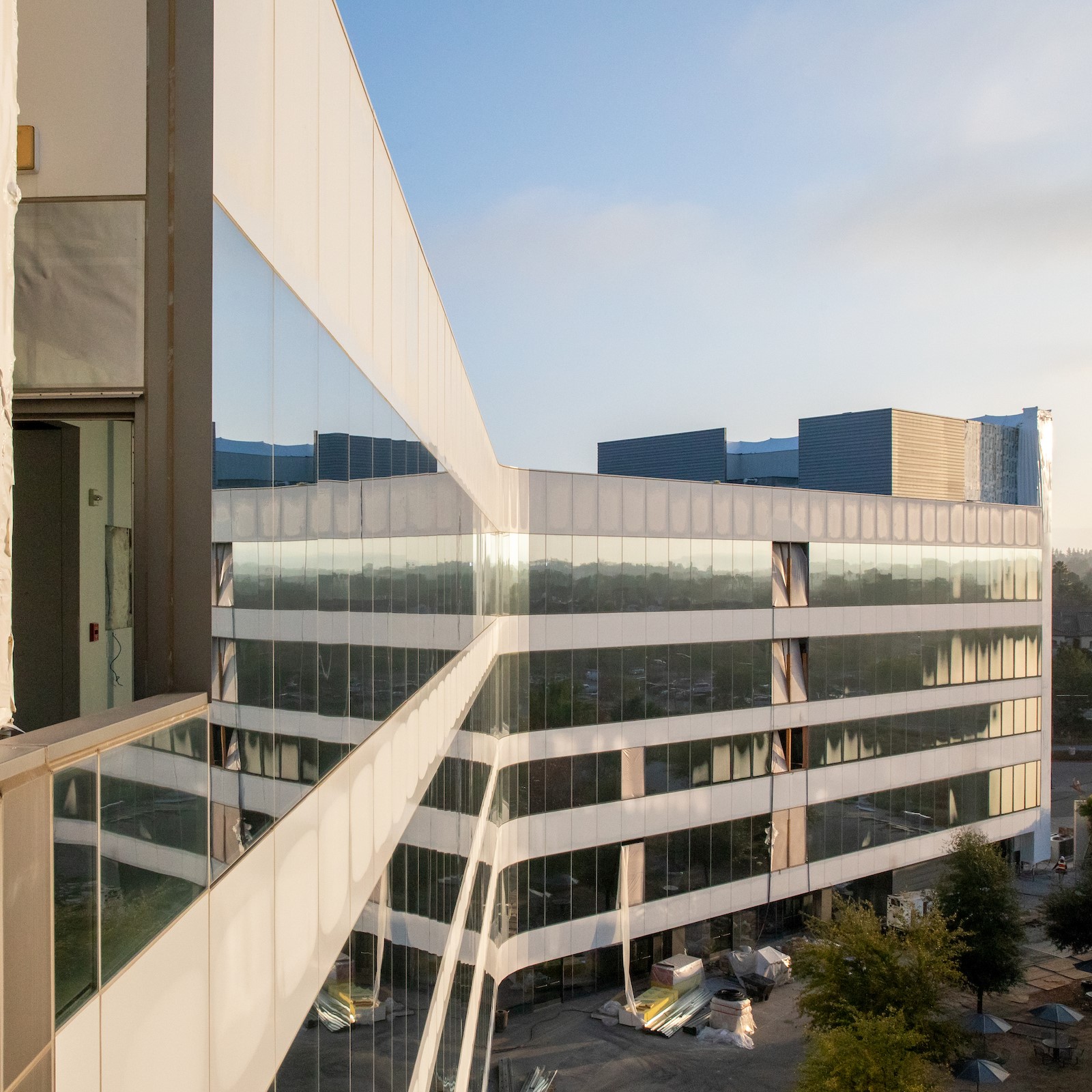Mt. San Jacinto College (MSJC), one of 115 community colleges in California, serves more than 26,500 students annually across a 1,700-square-mile area in western Riverside County. To expand access to higher education opportunities, the fast-growing institution is transforming an existing 350,000-square-foot office complex in Temecula into a cutting-edge academic facility.
The Temecula Valley Campus, located on 27 acres at 41888 Motor Car Parkway, will be conveniently accessible to students in MSJC’s southwest region who currently travel long distances to other campuses in San Jacinto, Menifee Valley, and San Gorgonio Pass. The $59 million project, part of MSJC’s districtwide five-year construction plan, will also address current shortages in classroom space.
“This new campus will allow us to achieve our goals of providing high-quality education that is convenient and accessible for our students,” says MSJC Vice President of Business Services, Beth Gomez. Other planned MSJC projects include two new STEM (Science, Technology, Engineering, and Mathematics) buildings at the San Jacinto and Menifee Valley campuses; a new Student Center at the Menifee Valley Campus; and a new 5,000-seat stadium in Menifee.
Roger Schultz, Superintendent and President of MSJC since 2008, comments, “It’s an exciting and transitional time at Mt. San Jacinto College, with many important milestones on the horizon.”
A Builder’s Extensive Expertise
C.W. Driver Companies (C.W. Driver) is serving as construction manager on the multiphase project in Temecula, which began construction in fall 2019. Founded more than a century ago, the Pasadena-based firm is one of the oldest and most prestigious builders in California.
“We are proud to partner with Mt. San Jacinto College to further its presence in the Temecula Valley area,” says Project Executive David Amundson. “C.W. Driver’s robust portfolio of higher education work, including our previous experience with community colleges across California, will help to ensure success in delivering a modern, effective facility for MSJC.”
In addition to Amundson, other key members of the C.W. Driver project team include Henri Duisters, Senior Project Manager; Richard Thurman, Senior Superintendent; and John Modena, Senior Estimator.
C.W. Driver has numerous signature projects in its higher education portfolio for both public and private institutions. Some recent examples include: a new 108,000-square-foot language arts/social sciences classroom building for Orange Coast College; a new 91,000-square-foot science/STEM education center for California State University’s Dominguez Hills campus; renovation of a 26,500-square-foot fine arts building for San Diego Mesa College; a new 150,000-square-foot science/engineering research facility for Chapman University; a new 138,400-square-foot student services building at Cal Poly Pomona; and a new 35,000-square-foot student center at Vanguard University.
Renovation Approach Saves Time, Money
On the Temecula Valley Campus project, the scope of work consists of renovating and seismically retrofitting two, five-story office building towers previously owned by Abbott Laboratories, a Fortune 500 company that specializes in health care products and devices. The property was purchased by the college district in March 2018 at a cost of $56.5 million using voter-approved Measure AA bond funds. The decision to renovate an existing facility versus building a brand-new one was made in an effort to save taxpayer dollars and accelerate the project timeline.
The first phase of construction, including all seismic retrofits and the full build-out of three floors, is expected to be completed in time for the spring 2021 semester. The second phase is slated to conclude by summer 2021. KPFF Consulting Engineers (KPFF), a global firm headquartered in Seattle, Washington, is providing all structural engineering services and a total of nearly 30 prime subcontractors will participate in various stages of the project.
An Award-Winning Design Partner
Another key project partner is 19six Architecture (formerly known as PMSM Architecture), a California-based operation that, like C.W. Driver, boasts exceptional longevity and an esteemed reputation. The architecture firm was contracted by MSJC to improve the facility’s life safety standards and provide design plans to convert half of the multi-building complex into a dynamic educational hub containing spaces for classrooms, laboratories, faculty offices, collaborative meeting spaces, recreational areas, and more.
Though the campus has yet to open, it is already receiving accolades for plans to transform it into an innovative, collaborative learning environment. Last year, the project was recognized by American School & University magazine for its outstanding interior design scheme, which places “emphasis on shared spaces where students from different classes can collaborate in a team environment.” The publication also applauded the implementation of key design features such as glass walls to create “transparency and visibility throughout the interior.”
A Unique and Complex Project
According to project spokespersons, this is one of the most unique higher education projects that C.W. Driver has ever participated in, which says a lot given the firm’s extensive expertise in this sector.
“Very rarely do we do something that’s this unique, where we’re taking an existing office building that was built to city codes and transforming it into a classroom building that is built to DSA codes,” says Amundson, referring to building codes and standards enforced by the state government’s Division of the State Architect. He notes how this type of atypical situation might become more common practice for college construction in urban environments, given the limited space to build new structures. He adds, “In my opinion, this is going to be the wave of the future and it’s exciting to be at the forefront of such a groundbreaking concept.”
The plan is to retrofit both of the building’s 175,000-square-foot towers, with initial work taking place in what the project team refers to as Building G. At the time of reporting, bids were underway for work on the other tower (Building F). According to project officials, some of the space in Building F may be leased out to other college institutions needing room for their higher education programs.
During the preconstruction phase, C.W. Driver actively worked with KPFF to ensure the final structural engineering plans factored in appropriate dynamic loading related to the existing structure, as well as potential impacts resulting from the proposed design. “Our team members, Richard Thurman especially, spent quite a bit of time identifying the areas in the structure that would have the least architectural impact,” Amundson says. “Because of our experience and efforts in this area, the job cost went down significantly.”
According to Duisters, the building was occupied very late into the design phases, preventing the architecture and engineering firms from obtaining comprehensive data on all existing conditions. Resultingly, there have been some clashes between existing conditions and the new design, which C.W. Driver has addressed through laser scanning of the existing conditions before installing HVAC systems, electrical wiring, etc.
Thus far, one of the most challenging construction tasks involved stripping down Building G to its core structural steel. “We had to go down 8 feet and reinforce the existing foundation. Then we had to strip the entire skin off two elevations for the structural upgrade,” Thurman says. “During the steel retrofit, we added steel plates to the existing steel columns, for all five levels, and also 4 feet below grade. In addition, the steel columns had to be reinforced to below grade, and the foundations had to be upgraded to meet the new seismic codes.” A total of 445 tons of structural steel was added to the building, and the new concrete foundations were strengthened by increasing the foundation size via epoxy doweled to the existing slab.
Duisters adds, “This facility is being constructed in compliance with the 2016 California Existing Building Code (2016 CEBC). However, as allowed by the 2016 CEBC and DSA, the analysis and retrofit of the project followed the nonlinear analysis procedures per the American Society of Civil Engineers’ ASCE 41-13 standard, Seismic Evaluation and Retrofit of Existing Buildings.”
Due to the tight confines of the building’s interior, crew members utilized a compact Brokk 500 demolition robot to break apart the existing foundations of other concrete components. The remote-controlled machine comes equipped with an intelligent electrical system that dynamically adjusts the power output for maximum performance, which further advances productivity.
The logistics of maneuvering materials into the building, which retained its exterior walls, has been another pain point. Last October, for example, the fifth-floor support structure had to be reinforced with 22 steel beams. Using a truck crane, the construction team carefully hoisted the structural steel members, each one measuring 30 feet long and weighing 1,500 pounds, into the building through a narrow 8-foot by 6-foot window opening. The precision required to execute this task without damaging the building finishes demonstrates the team’s streamlined coordination and attention to detail.
Once retrofit activities wrapped up in February 2020, crews moved forward with the tenant build-out phase of construction. The current focus is on levels one, four, and five of the multistory structure, which are intended to be ready for occupancy next spring. Construction on levels two and three will then proceed over the course of the next year while students, faculty, and other staff are on the premises.
One key feature of the project is the two-story lobby at the main entrance on the ground floor, which will be complemented by a new lobby staircase. A two-story conference room will be located directly above the lobby. The outer facade of the building – a modern combination of sleek silver metal paneling and glass curtain wall – will remain unchanged.
Similar to how a traditional college campus has standalone buildings differentiated by unique designs, the five levels of the Temecula Valley Campus will each have a distinctive theme showcasing various colors and architectural finishes. Once completed, the “vertical campus” will contain 22 classrooms, six science labs, and five computer classrooms. It will also include a student services center for enrollment, counseling, and financial aid as well as a resource center for veterans, a health center, a library, dining options, and other educational facilities and support services.
According to college spokespersons, the Temecula Valley Campus is planning to welcome 1,500 students when it first opens. Future projections show enrollment could increase to 6,000 by fall 2024. Clearly, the addition of this new campus in the Mt. San Jacinto College system is both timely and essential to facilitate access to higher education opportunities in the region.
See the full article here.


